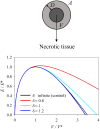Microenvironment-mediated cancer dormancy: Insights from metastability theory
- PMID: 34949715
- PMCID: PMC8740765
- DOI: 10.1073/pnas.2111046118
Microenvironment-mediated cancer dormancy: Insights from metastability theory
Abstract
Dormancy is an evolutionarily conserved protective mechanism widely observed in nature. A pathological example is found during cancer metastasis, where cancer cells disseminate from the primary tumor, home to secondary organs, and enter a growth-arrested state, which could last for decades. Recent studies have pointed toward the microenvironment being heavily involved in inducing, preserving, or ceasing this dormant state, with a strong focus on identifying specific molecular mechanisms and signaling pathways. Increasing evidence now suggests the existence of an interplay between intracellular as well as extracellular biochemical and mechanical cues in guiding such processes. Despite the inherent complexities associated with dormancy, proliferation, and growth of cancer cells and tumor tissues, viewing these phenomena from a physical perspective allows for a more global description, independent from many details of the systems. Building on the analogies between tissues and fluids and thermodynamic phase separation concepts, we classify a number of proposed mechanisms in terms of a thermodynamic metastability of the tumor with respect to growth. This can be governed by interaction with the microenvironment in the form of adherence (wetting) to a substrate or by mechanical confinement of the surrounding extracellular matrix. By drawing parallels with clinical and experimental data, we advance the notion that the local energy minima, or metastable states, emerging in the tissue droplet growth kinetics can be associated with a dormant state. Despite its simplicity, the provided framework captures several aspects associated with cancer dormancy and tumor growth.
Keywords: cancer dormancy; extracellular matrix; metastability; phase separation; tissue growth.
Copyright © 2021 the Author(s). Published by PNAS.
Conflict of interest statement
The authors declare no competing interest.
Figures




References
-
- Bissell M. J., Hall H. G., Parry G., How does the extracellular matrix direct gene expression? J. Theor. Biol. 99, 31–68 (1982). - PubMed
Publication types
MeSH terms
LinkOut - more resources
Full Text Sources
Medical

